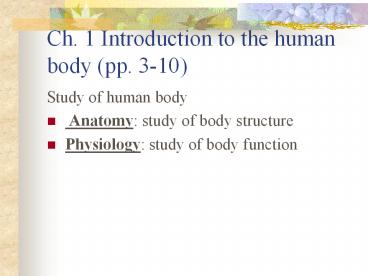Ch. 1 Introduction to the human body (pp. 3-10) PowerPoint PPT Presentation
Title: Ch. 1 Introduction to the human body (pp. 3-10)
1
Ch. 1 Introduction to the human body (pp. 3-10)
- Study of human body
- Anatomy study of body structure
- Physiology study of body function
2
Anatomy cutting up
- Location, what it looks like
- Gross anatomy study of body structures visible
to the naked eye - Microanatomy needs microscope. Histology is the
study of tissues which is a type of microanatomy
- Systemic anatomy studies body structures with in
a given organ system like the digestive, muscular
or skeletal systems - Regional anatomy studies all structures with in
a given region of the body like the head or leg.
3
Physiology study of nature
- How does it work
- The way the body obtains energy and manages its
use in order to maintain stability
4
Directional terms
- Anatomical position (p.6 fig. 1-2) is the
position of a person standing upright facing the
observer with arms at sides and toes and palms
turned forward - Copy table 1-1
5
Directional terms
- Superior (cranial) towards head
- Inferior (caudal) away from head
- Anterior (ventral) towards the front or belly
side - Posterior (dorsal) towards the back side
- Medial towards midline of body
- Lateral away from midline
- Superficial (external) towards surface of body
- Deep (internal) inward from surface
- Proximal towards structures origin to trunk
- Distal away from structures origin to trunk
6
Directional terms
- EX. Look at wrist and elbow, the elbow is
proximal with respect to the wrist because it is
closer to the point of attachment to the trunk.
- http//www.whitman.edu/biology/vpd/anaref.html
7
Body planes
- Imaginary flat surfaces
- Sagittal
- Frontal
- Horizontal
8
Sagittal Plane
- Divides body into left and right sides
- midsagittal equal left and right
- parasagittal non equal left and right
9
Frontal (Coronal) Plane
- Divides body into anterior (ventral) and
posterior (dorsal)
10
Horizontal (Transverse Plane)
- Divides body into superior and inferior
- Questions 1-30
11
Structural levels of organization
- How the body is organized from simple to complex
- Atoms ? molecules ? cell ? tissue ? organs ?
organ systems ? organism
12
1. Cells
- Formed from combination of molecules
- They are the basic structural and functional
units of life - Smallest living parts of the body
- Macromolecules large provide structural
foundation - proteins, fats, carbohydrates and nucleic acids
13
2. Tissue
- group of similar cells combined to perform
a common function. There are 4 types - A. epithelial close arrangement of cells
with little intercellular material. Covers body
surface, lines inside of organs and body
cavities, forms glands.
- B. connective abundance of
extracellular material with few cells. Function
in support and binding of body structures - C. muscle specialization to contract
- D. nervous sends nervous signals
14
4 Tissue Types
15
3. Organ
- Two or more different types of tissue which
combine and form a general function - Organs usually have distinct shapes
16
4. System
- Organization of 2 or more organs and their
associated structures
17
1. Integumentary System
- Organs skin
- Function protects underlying structures and loss
of body fluid
18
2. Muscular System
- Organs Muscles
- Function
- movement
19
3. Skeletal System
- Organs bone
- Function support and protection of softer body
parts
20
4. Nervous System
- Organs brain, nerves, spinal cord
- Function controls homeostasis by causing muscles
to contract and glands - to secrete
21
5. Endocrine System
- Organs pituitary,thyroid,adrenal, pancreas,
gonads Function release hormones
22
6. Cardiovascular System
- Organsheart,
- arteries,veins Function transport materials
to and from body cells
23
7. Lymphatic System
- Organsspleen,
- thymus, tonsils,vessels Function remove
dead cells and foreign bodies
24
8. Respiratory System
- Organs larynx,trachea, lungs
- Function gas exchange between blood and
external environment
25
9. Digestive System
- Organs esophagus, stomach,
small and large intestines, liver - Function break apart food for absorption to
blood
26
10. Urinary System
- Organskidneys,
- ureters, bladder,
- urethra
- Function control
- water and salt
- balance.
27
11. Reproductive System
- Organstestes,
- urethra,penis,
- ovaries,uterus,
- vagina
- Function
- production of
- new individuals
28
5. Complete Organism
- Composed of many systems, which depend on one
another to perform. Survival and reproduction
are the goals of the bodys internal activities. - Questions 31-59

